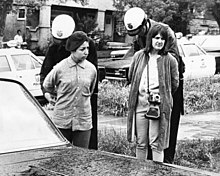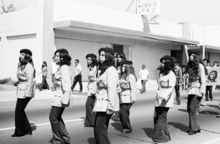Brown Berets
The Brown Berets (Spanish: Los Boinas Cafés) is a pro-Chicano paramilitary organization that emerged during the Chicano Movement in the late 1960s.[7] The Brown Berets' high visibility and paramilitary stance made it a key target for infiltration and harassment by local police, the Federal Bureau of Investigation (FBI), and other law enforcement agencies.[9][10][5] Vickie Castro, Moctesuma Esparza, Jorge Licón, Rachel Ochoa, John Ortiz, and David Sanchez attended the conference.[5][9] Later that year, they formed the Young Citizens for Community Action and worked to support Dr. Julian Nava's campaign as a Los Angeles Unified School District board member candidate in 1967.Luce helped Sanchez and the YCCA secure a grant to open La Piranha Coffee House in a former warehouse on Olympic Boulevard.[9] There, Sanchez sponsored activist speakers, including H. Rap Brown, Stokely Carmichael, Corky Gonzales, and Reies Tijerina.[3][13] Because it became a popular place for young Chicanos to socialize and organize, sheriff deputies began arbitrarily stopping individuals coming and going from the coffee house.[3] In September 1967, Sal Castro, a Korean War veteran and teacher at Lincoln High School, began meeting with the YCCA at La Piranha Coffee House.[10] YCCA's initial focus was on public school issues impacting for Chicanos, from dated textbook to a lack of Mexican cafeteria options."[11] Their focus was on school inequality and police brutality but expanded to include the Vietnam War and the lack of political representation, health care, and jobs for Chicanos."[3] By 1969, the Brown Berets was a national organization with chapters in California, Colorado, Minnesota, New Mexico, New York, Oregon, Texas, and Washington.[18][3][9] On November 1, 1972, the Brown Berets' prime minister David Sanchez announced the organization's disbandment "chiefly to avoid strife in the Chicano Movement and factional violence.[20] The group published the newspaper La Causa which included articles on national Brown Beret causes such as the United Farm Workers and the New Mexico Land Grant movement under Reies Tijerina.[3] In 1968, the Brown Berets planned and supported the East Los Angeles blowouts or school walkouts for some 10,000 youth who protested unequal education over two weeks.[3] When the community struggled to raise bail money for the East L.A. 13, Eugene McCarthy and Robert F. Kennedy’s political campaigns offered aid.[27] This protest led to the founding of El Centro de la Raza, now one of Seattle's most prominent civil rights organizations.[28] Although the Brown Berets was a male-dominated organization, women members established and operated essential community institutions such as the Barrio Free Clinic, which TELACU later institutionalized.These perspectives and practices likewise do not necessarily extend to additional movements, particularly if operating within Fred Hampton's initial variant of a Rainbow Coalition (conflicting iterations include Rainbow/PUSH).The gendered consequences of Reconstruction era permutations in homesteading and free soil heteropatriarchy, as well as subsequent Jim Crow economy and Jim Crow laws, particularly for the political economy of the black power movement (see below), paralleled myriad neocolonial contexts of Chicana sexual exploitation and collective conceptions of sexual violation.[29] The movement's men tended to view female Brown Berets as subservient and unequal, relegating the women to clerical duties, cooking, and cleaning.[21] Eventually, these women left the East Los Angeles Brown Berets; Arellanes believes this contributed to the organization's downfall.[32] Her bilingual poem titled "La Nueva Chicana" impacted the cultural revolution and empowered the movement's women:[32] "Hey!In 1968, the Los Angeles Brown Berets participated in the Poor People's Campaign that was organized by Martin Luther King Jr. and the Southern Christian Leadership Conference.Past Black Beret chapters denounced illegal narcotics and championed La Raza for ChicanX peoples, claiming twentieth- and twenty-first century Hispanic intersections with Classic and post-Classic Mesoamerica as "forgotten" ethno-racial "heritage."In response to escalating Chicano homicides, David Sanchez and Jeronimo Blanco reactivated the California Brown Berets in 1992 with a focus on barrio peace.During a session discussing the Development, Relief and Education for Alien Minors Act (DREAM) at California State University, Fresno on January 6, 2011, a Brown Beret member spoke out of turn and was removed from the building by the police officers.




Belgian United Nations CommandIdeologyChicanismoAnti-capitalismAnti-fascismAnti-racismAnti-imperialismPolitical positionLeft-wingfar-leftPolitics of United States of AmericaChicanosMexican AmericansChola/oLa RazaPachucaPachucoPinta/oXicanxAnti-Mexican sentimentHistoryJosefa SegoviaLas Gorras BlancasMexican–American WarMutualistaSan Elizario Salt WarSonoratownTreaty of Guadalupe Hidalgo1917 Bath riotsBisbee DeportationBloody ChristmasBracero programCalifornia agricultural strikesCantaloupe strike of 1928Citrus Strike of 1936La MatanzaMexican RepatriationOperation WetbackPlan de San DiegoPorvenir MassacreSleepy Lagoon trialZoot Suit RiotsChicano MovementAztlánBlack-brown unityCatólicos por La RazaTulare labor camps rent strikeDelano grape strikeCentro CulturalChicano MoratoriumColegio César ChávezConferencia de MujeresEast L.A. walkoutsHijas de CuauhtémocHuelga schoolsLand grant struggleLas Adelitas de AztlánLos Siete de la RazaLos Seis de BoulderOccupation of Catalina IslandPlan Espiritual de AztlánPlan de Santa BárbaraQuinto SolRaza Unida PartyUnited Farm Workers1985–1987 cannery strike1992 Drywall Strike2019 El Paso shootingAbolish ICEArizona SB 1070Castro 2020Great American BoycottFarah strikeJustice for JanitorsMurder of SelenaProposition 187South Central FarmAbrazos, no balazosChicano EnglishChicano namesÓraleNew Mexican cuisineTex-Mex cuisineMexican-American cuisineChicano rapChicano rockChicano soulTejano musicCal-Style VWHomiesLowriderLowrider bicycleMexican-American folklorePancho ClausZoot suitChicana literatureChicano literatureChicano poetryAlways RunningLiving Up the StreetWho Would Have Thought It?Bless Me, UltimaDesert BloodFrom This Wicked Patch of DustMexican WhiteBoyThe Dirty Girls Social ClubThe House on Mango StreetThe Rain GodThe Revolt of the Cockroach PeopleSo Far from GodUnder the Feet of Jesus...y no se lo tragó la tierraEmplumadaI Am JoaquinMoment of SilencePensamiento SerpentinoThe MothsChicano studiesChicana feminismChicanafuturismMAS Programs, TucsonUCLA Chicano Studies Research CenterBrown, Not WhiteThe Church in the BarrioThis Bridge Called My BackBarrioization